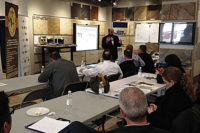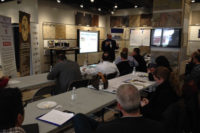Tony Malisani of Malisani, Inc. in Great Falls, MT, and current president of the MIA, gave an in-depth presentation about "How to Set a Cost and Sell a Project's Value," and led the overall discussion amongst attendees, detailing topics such as pricing strategies, marketing techniques, different selling methods and how to better understand/measure your overall business. "Education is important, so make yourself the expert," he told the audience. "Take that opportunity. The information is there -- it's available to everybody."
In the beginning of Malisani's presentation, he discussed the various aspects of pricing and how it affects each business differently. "You have to know what it costs you to do what you're doing," he said. "Although prices [for certain materials] may be the same, all companies' pricing processes are different."
Marco Duran of Atlas Marble and Granite in Springfield, NJ, confirmed this point from a fabricator's point of view. "Things differ in every state," he said, referring to the prices of materials which vary based on location. "What may apply for you doesn't for me."
During the discussion of businesses' finances, various topics arose, including the types of costs (direct and indirect); bidding, pricing and estimating; production metrics; and actual costs and how to track them (via software, time sheets, job cost sheets and job reports). Malisani also explained how to follow up on these results, and in turn, measure the effectiveness and success of your business -- whether it's reviewing all profits, comparing results or making changes.
To stand out from other companies and remain competitive in today's market, Malisani lent some helpful tips on what companies should be focusing on, such as appearance and branding. "If you dress more professional, you come off more professional and are more respected," he said. "Also focus on the cleanliness of your facility and showroom. It's all about perception." He also relayed three main tips on "how to be more successful" -- adapting to current industry trends and demands, broadening your customer base and product offerings and creating a five- to 10-year success and planning model.
One of the most important parts of a business' success is how much it profits, a topic Malisani went into much depth about as he detailed a wide range of pricing strategies that help companies maximize their profits, including:
- Loss leader. "Lure customers to the business for further purchases and upcharges. Should be paired with quantity maximization or partial cost recovery pricing objectives."
- Competitive pricing by square foot. "Useful to keep market reasonably safe, not good for differentiating business, and may not be good for profit margins in some markets, as it is very common."
- Variations of pricing. "This is a 'building block style of pricing' that helps compare apples to apples, and is a full spectrum of what you can do. It attracts a broad base of customers (retail, kitchen & bath dealer, designer, contractor, developer) and helps you get into markets you wouldn't otherwise penetrate."
- Multiple pricing and product bundle pricing. "Used for large/wholesale jobs, this option encourages use of product in greater quantity by offering discounts. It rolls ordinary charges into prices and works well with profit maximization and quantity, but narrows the scope of customers."
- De-bundled square foot pricing."Encourages customers to upgrade and choose options of their choice. Upselling helps with revenue maximization. Often used for retail sales, it's easy for customers to comparison shop."
- Premium/custom pricing. "This is used when selling is unique and of very high quality, as there are greater administrative costs."
- Penetration pricing. "This is trying to take out some of the competition. Lower your prices accordingly and then raise them back to normal."
"Look at who is successful and emulate it," said Malisani. "The better job you do at planning, the better you'll execute something."
Understanding and measuring your business
When it comes down to the nitty-gritty, companies like to understand how their overall business is doing, and the best way to assess that is by measuring all aspects of your business, from pricing and marketing to costs and profits.
Marketing techniques are one of the strongest intangible advisors a company can possess, and they are critical to the exposure of any particular product(s). Although there are countless different marketing strategies available today, Malisani discussed which techniques work, which don't, and how to be clear in what you're promoting and advertising. He also ventured into more personal business information -- business mission statements, future business plans, current customers, new customers/target audience, competitors, and how to stand out -- educating attendees on how to fully understand their business and all it entails; while also touching on tracking costs -- through software, time sheets, job cost sheets, material cost lists, efficiency analyses, profit reviews, result comparisons and resulting changes -- to help attendees better measure their businesses.
Meeting customer needs
One of the major parts of a business' success is its customers, who vary from market to market and are essential to the continuation of any business. Customers are never shy when it comes to expressing how or when they want something, which is one aspect of the process that makes it that much easier for business owners, according to Malisani. "Your customers will tell you what else you should be doing," he said.
Malisani also said customers are like living, tangible marketing techniques, which when treated with care, can be the best source of referrals for any business. "We're selling an experience, and when you sell an experience is when you're going to succeed," he said. "Buying is an emotional act. Make buying your product from you easy."
Customers nowadays are also way more educated about various stone and tile applications and conditions, largely due to the Internet, another reason why companies need to be on the forefront of industry trends. "There is more good information available now than there used to be," said one member of the audience. "[Customers] have their own ideas and information, so you need to be prepared for those customers. It's not as easy as it used to be." As an example, the audience member added that she offers extended warranties. "I only have to guarantee one year, but I do five-year guarantees," she said.
Look for a report on the Fabricator Forum, which took place during the New Jersey Stone Summit, in an upcoming issue of Stone World.





